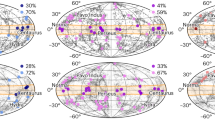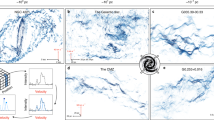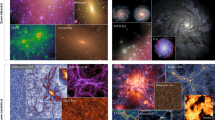Abstract
Did the large-scale distribution of matter in the Universe evolve by a dissipationless process (such as hierarchical clustering) or is it the result of a strongly dissipative event (such as the ‘pancake’ scenario)? If the distribution of galaxies in the Universe can be treated as a dissipationless fluid, then an application of Liouville's theorem predicts a linear relationship between the observed galaxy density and the cube of the velocity dispersion as measured at any point in space. Evidence from existing cluster data is presented here which supports this hypothesis.
This is a preview of subscription content, access via your institution
Access options
Subscribe to this journal
Receive 51 print issues and online access
$199.00 per year
only $3.90 per issue
Buy this article
- Purchase on Springer Link
- Instant access to full article PDF
Prices may be subject to local taxes which are calculated during checkout
Similar content being viewed by others
References
Abell, G. O. Astrophys. J. Suppl. 31, 211–288 (1958).
Struble, M. F. & Rood, H. J. Astr. J. 87, 7–39 (1982).
Struble, M. F. & Rood, H. J. Astr. J. 89, 1487–1513 (1984).
Geller, M. J. & Huchra, J. P. Astrophys. J. Suppl. 52, 61–84 (1983).
Felten, J. E. Astr. J. 82, 861–878 (1977).
Tammann, G. A., Yahil, A. & Sandage, A. Astrophys. J. 234, 775–784 (1980).
Ellis, R. in The Origin and Evolution of Galaxies (eds Jones, B. J. T. & Jones, J. E.) 255–296 (Reidel, Dordrecht, 1983).
Fesenko, B. I. Soviet Astr. 17, 314–316 (1973).
Tsvetkov, D. Yu. Soviet Astr. 25, 416–420 (1981).
Huchtmeier, W. K. in Clusters and Groups of Galaxies (eds Mardirossian, F., Giuricin, G. & Mazzetti, M. 221–242 (Reidel, Dordrecht, 1983).
Davis, M. & Peebles, P. J. E. Astrophys. J. 267, 465–482 (1984).
Sandage, A. & Tammann, G. A. Astrophys. J. 210, 7–24 (1976).
Rivolo, A. R. & Yahil, A. Astrophys. J. 251, 477–484 (1981).
Lynden-Bell, D. Mon. Not. R. astr. Soc. 136, 101–121 (1967).
Author information
Authors and Affiliations
Rights and permissions
About this article
Cite this article
Rivolo, A. Liouville's theorem and the velocity field of galaxies. Nature 317, 788–789 (1985). https://doi.org/10.1038/317788a0
Received:
Accepted:
Published:
Issue Date:
DOI: https://doi.org/10.1038/317788a0
This article is cited by
-
Double clusters and gravitational lenses
Nature (1986)
Comments
By submitting a comment you agree to abide by our Terms and Community Guidelines. If you find something abusive or that does not comply with our terms or guidelines please flag it as inappropriate.



